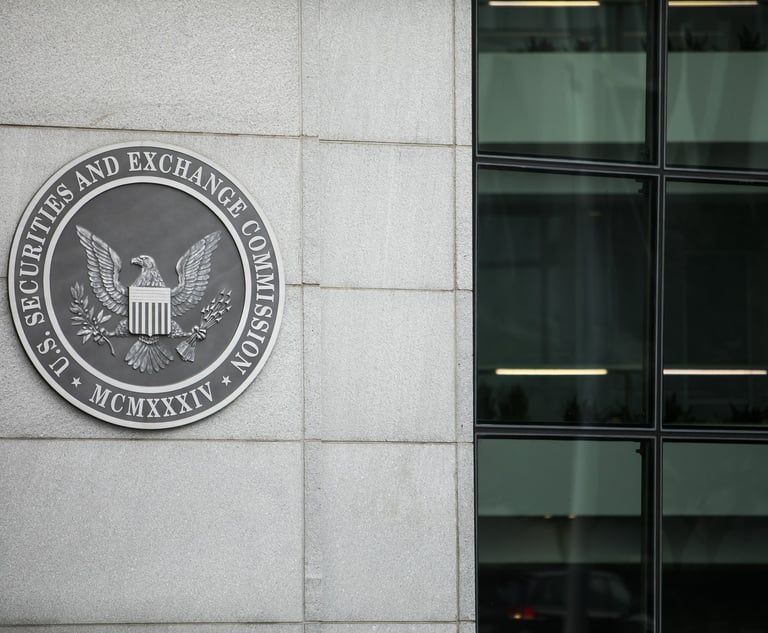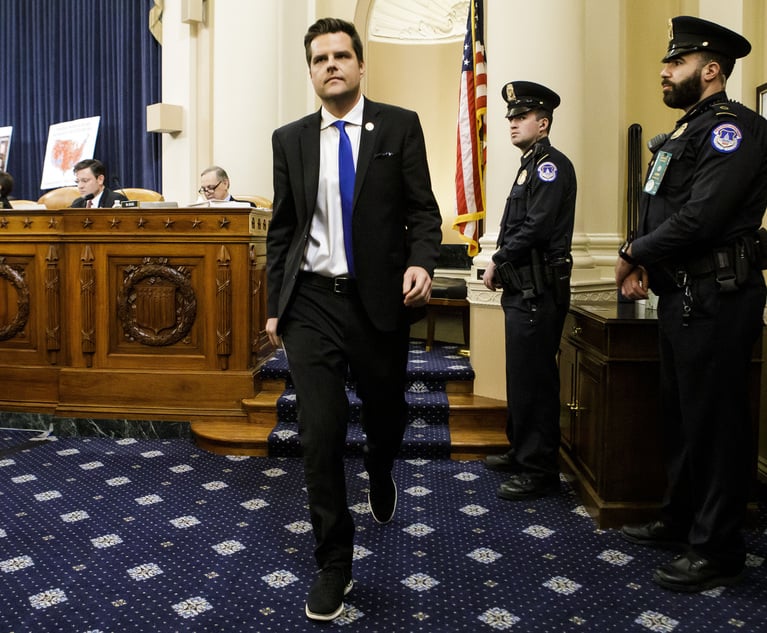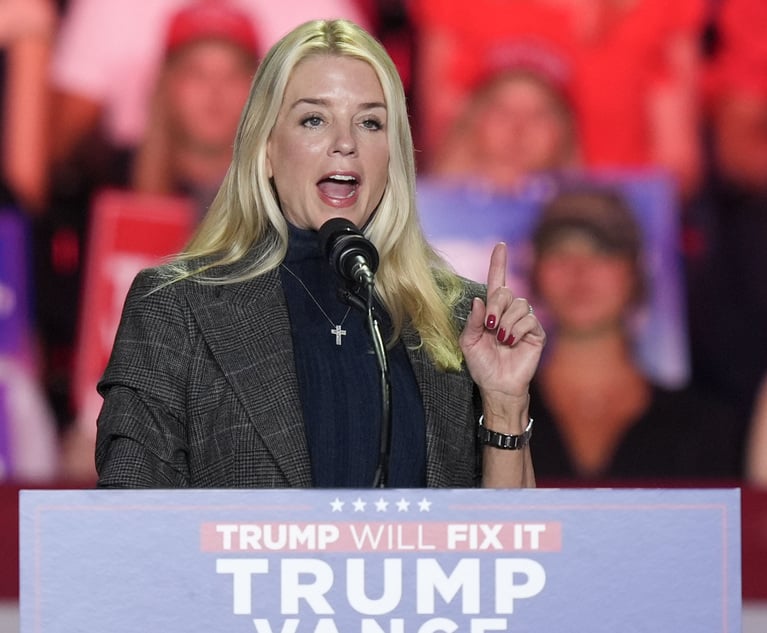 Photo: Shutterstock
Photo: ShutterstockCritical Deadline Looms for Some Victims of Vaccine-Related Injuries
Last year, the federal government officially recognized two new vaccine-related injuries, and it has given potential victims a rare extension to file…
February 07, 2019 at 02:30 PM
7 minute read
Last year, the federal government officially recognized two new vaccine-related injuries, and it has given potential victims a rare extension to file claims for compensation.
With an early 2019 deadline now fast-approaching, this is an excellent moment to review what is covered under the extension and how the program for vaccine-related claims works for injured parties.
The National Vaccine Injury Compensation Program, or NVICP, compensates individuals who have been injured or who have died as the result of an inoculation. Sometimes referred to as the “vaccine court,” the NVICP covers many, but not all, of the most common vaccines.
The program in 2017 added shoulder injuries related to the way a vaccine is administered and Guillain-Barré syndrome contracted after flu shots to the Vaccine Injury Table. The table is the official list of vaccines and injuries eligible for NVICP claims.
In general, the program follows strict statutes of limitations on claims. In this case, however, those time limits have been relaxed. If, during the period between March 21, 2009 and March 21, 2017, victims suffered from Guillain-Barré syndrome following a flu shot or if they received a shoulder injury related to a vaccine, they may still file a claim.
Any claim that falls within these circumstances must now be filed by March 21, 2019. This applies even if the complainants had previously filed a claim alleging a Guillain-Barré syndrome or shoulder injury but were dismissed.
|How the Changes Were Made
Two federal agencies, the Department of Health and Human Services and the Centers for Disease Control and Prevention, periodically review and modify the list of vaccines that are covered under the NVICP via rule changes published in the Federal Register. The agencies also commission research work groups to study vaccines and review medical reports from reputable sources.
In 2015, as a result of a report by the Institute of Medicine, shoulder injuries and Guillain-Barré Syndrome were proposed as additions to the vaccine injury table. A public comment and review period followed, and the rule changes were published on Jan. 19, 2017.
In the last few years, shoulder-related vaccine injuries have become one of the most common complaints. In fact, 50 percent of alleged vaccine injuries are related to how inoculations are delivered. Shoulder injuries are so common that they have received an acronym of their own, SIRVA, for “shoulder injury resulting from vaccine administration.”
In cases involving improper administration, injured petitioners generally allege the that injection was given too high on the arm. Vaccines are supposed to be administered in the deltoid muscle, or the thick part of the upper arm, but can be problematic if they are given too close to the shoulder.
The American Academy of Pediatrics examined SIRVA injuries recently. It describes SIRVA as “a specific condition that is associated with vaccine inadvertently administered into the deltoid bursa or joint space. Patients with SIRVA experience a shoulder injury that is more severe than would be expected from just needle trauma.” One theory is that improperly administered vaccines trigger an inflammatory reaction that is responsible for SIRVA complaints. In 13 adult cases reported by NVICP, shoulder pain and a limited range of motion was noted immediately.
According to the Mayo Clinic, Guillain-Barré syndrome is a rare disorder in which the body's immune system attacks the peripheral nerves. Weakness and tingling or numbness in the extremities are usually the first symptoms. These sensations can spread quickly, eventually paralyzing the whole body. In its most severe form, Guillain-Barré syndrome is a medical emergency. Many people with the condition must be hospitalized to receive treatment.
The exact cause of Guillain-Barré syndrome is not always known, but it is often preceded by an infectious illness. Mayo Clinic also adds that, in rare cases, recent immunizations can trigger the condition. Guillain-Barré syndrome has been linked to vaccines for influenza and others, including diphtheria, tetanus and acellular pertussis (DTaP), hepatitis A and B and meningitis.
|A 'No Fault' Venue
The safety of commonly administered vaccines, particularly those given to children, has been one of the more controversial public health issues in recent years. Complaints range from their efficacy to possible deleterious side effects. The most common allegations involve side effects from the widely circulated flu vaccine administered at doctors' offices and chain drugstores nationwide.
Despite the complaints, vaccines have been repeatedly proven to be effective, and in many cases, genuine lifesavers. Consider, for example, the tetanus vaccine, which is second only to the flu vaccine in number of administered doses. According to Science Online, the injury rate from the tetanus vaccine is just 0.0006 percent.
Still, injuries do happen, and legal redress is available. In 1986, Congress passed, and President Reagan signed the National Childhood Vaccine Injury Act to help shield pharmaceutical companies from financially ruinous mass tort actions over vaccine injuries. The government agreed to the program partly because it feared an inadequate supply of vaccines if drug makers were to withdraw from the market.
The NVICP, which was established under the Act, provides for a separate “no fault” process for handling vaccine complaints. An alternative to the traditional legal system, the program allows vaccine-injured petitioners to seek monetary compensation on an individual basis. It does not, however, allow for classes of individuals to bring actions.
So far, nearly 17,000 cases have been adjudicated under the program. Injured complainants do face a lengthy procedure, with some receiving compensation and some being dismissed without compensation. Vaccines covered under the NVICP include those for tetanus, pertussis, diphtheria, hepatitis A and B, seasonal flu, measles/mumps/rubella, polio, human papillomavirus and rotavirus, among others.
That said, not all vaccines administered in the United States are covered by the NVICP. Specifically, vaccines administered exclusively to adults are not covered in the NVICP and can be the subject of a civil complaint. Controversy over a widely administered vaccine for shingles, for example, is currently being played out in the civil courts. Also, occasional disputes arise over which vaccines should and should not be covered, especially as new vaccines are formulated.
|Filing a Claim
Filing a NVICP complaint differs from filing a traditional lawsuit. With the exception of the temporary extension for sufferers of shoulder pain and Guillain-Barré syndrome sufferers, complainants must file within three years of the first symptoms of the injury, or two years of death and within four years of the first symptom if it resulted in death.
Injured parties have to file in the U.S. Court of Federal Claims. While there is a $400 fee to file a claim, which may be reimbursed at the conclusion of a claim, petitioners do not pay their attorney fees. The fee structure is unique—attorneys may recover their fees from the Vaccine Program itself, not the injured petitioner.
To qualify, the effects of the injury must have lasted for more than six months after the vaccination, resulted in death or resulted in inpatient hospitalization and surgery. Parents, guardians, and legal representatives of deceased persons can file. The vaccine must have been administered or made in the United States and the affected person must have returned to the U.S. within six months of receiving it. (Exceptions exist for armed forces dependents.)
The NVICP, which is celebrating its 30th anniversary this year, remains the sole vehicle of legal redress for covered vaccines. Despite rigorous time limits and scrutiny of claims, the government body supervising the programs makes occasional changes as research identifies previously unknown symptoms.
While an injured party can file a claim in the NVICP without assistance of an attorney, the unique procedures in the Vaccine Program can be nuanced and difficult to manage. Potential claimants can benefit greatly with the assistance of an attorney experienced in vaccine law at no cost to them.
Christina Ciampolillo is a junior partner at Conway Homer, P.C., a firm that limits its practice exclusively to litigation in the National Childhood Vaccine Injury Compensation Program, where it has been a proponent of vaccine-injured litigants since the Program's inception.
This content has been archived. It is available through our partners, LexisNexis® and Bloomberg Law.
To view this content, please continue to their sites.
Not a Lexis Subscriber?
Subscribe Now
Not a Bloomberg Law Subscriber?
Subscribe Now
NOT FOR REPRINT
© 2024 ALM Global, LLC, All Rights Reserved. Request academic re-use from www.copyright.com. All other uses, submit a request to [email protected]. For more information visit Asset & Logo Licensing.
You Might Like
View All
Trump's SEC Overhaul: What It Means for Big Law Capital Markets, Crypto Work

From ‘Deep Sadness’ to Little Concern, Gaetz’s Nomination Draws Sharp Reaction From Lawyers
7 minute read
Trump Picks Personal Criminal Defense Lawyers for Solicitor General, Deputy Attorney General
Trending Stories
- 1Judge Grants Special Counsel's Motion, Dismisses Criminal Case Against Trump Without Prejudice
- 2GEICO, Travelers to Pay NY $11.3M for Cybersecurity Breaches
- 3'Professional Misconduct': Maryland Supreme Court Disbars 86-Year-Old Attorney
- 4Capital Markets Partners Expect IPO Resurgence During Trump Administration
- 5Chief Assistant District Attorney and Litigator Shortlisted for Paulding County Judgeship
Who Got The Work
Michael G. Bongiorno, Andrew Scott Dulberg and Elizabeth E. Driscoll from Wilmer Cutler Pickering Hale and Dorr have stepped in to represent Symbotic Inc., an A.I.-enabled technology platform that focuses on increasing supply chain efficiency, and other defendants in a pending shareholder derivative lawsuit. The case, filed Oct. 2 in Massachusetts District Court by the Brown Law Firm on behalf of Stephen Austen, accuses certain officers and directors of misleading investors in regard to Symbotic's potential for margin growth by failing to disclose that the company was not equipped to timely deploy its systems or manage expenses through project delays. The case, assigned to U.S. District Judge Nathaniel M. Gorton, is 1:24-cv-12522, Austen v. Cohen et al.
Who Got The Work
Edmund Polubinski and Marie Killmond of Davis Polk & Wardwell have entered appearances for data platform software development company MongoDB and other defendants in a pending shareholder derivative lawsuit. The action, filed Oct. 7 in New York Southern District Court by the Brown Law Firm, accuses the company's directors and/or officers of falsely expressing confidence in the company’s restructuring of its sales incentive plan and downplaying the severity of decreases in its upfront commitments. The case is 1:24-cv-07594, Roy v. Ittycheria et al.
Who Got The Work
Amy O. Bruchs and Kurt F. Ellison of Michael Best & Friedrich have entered appearances for Epic Systems Corp. in a pending employment discrimination lawsuit. The suit was filed Sept. 7 in Wisconsin Western District Court by Levine Eisberner LLC and Siri & Glimstad on behalf of a project manager who claims that he was wrongfully terminated after applying for a religious exemption to the defendant's COVID-19 vaccine mandate. The case, assigned to U.S. Magistrate Judge Anita Marie Boor, is 3:24-cv-00630, Secker, Nathan v. Epic Systems Corporation.
Who Got The Work
David X. Sullivan, Thomas J. Finn and Gregory A. Hall from McCarter & English have entered appearances for Sunrun Installation Services in a pending civil rights lawsuit. The complaint was filed Sept. 4 in Connecticut District Court by attorney Robert M. Berke on behalf of former employee George Edward Steins, who was arrested and charged with employing an unregistered home improvement salesperson. The complaint alleges that had Sunrun informed the Connecticut Department of Consumer Protection that the plaintiff's employment had ended in 2017 and that he no longer held Sunrun's home improvement contractor license, he would not have been hit with charges, which were dismissed in May 2024. The case, assigned to U.S. District Judge Jeffrey A. Meyer, is 3:24-cv-01423, Steins v. Sunrun, Inc. et al.
Who Got The Work
Greenberg Traurig shareholder Joshua L. Raskin has entered an appearance for boohoo.com UK Ltd. in a pending patent infringement lawsuit. The suit, filed Sept. 3 in Texas Eastern District Court by Rozier Hardt McDonough on behalf of Alto Dynamics, asserts five patents related to an online shopping platform. The case, assigned to U.S. District Judge Rodney Gilstrap, is 2:24-cv-00719, Alto Dynamics, LLC v. boohoo.com UK Limited.
Featured Firms
Law Offices of Gary Martin Hays & Associates, P.C.
(470) 294-1674
Law Offices of Mark E. Salomone
(857) 444-6468
Smith & Hassler
(713) 739-1250







